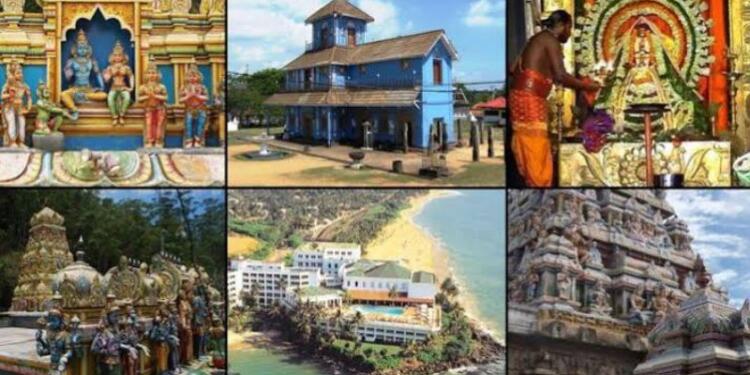The world is on the path of resurgence from the apologetic approach towards spirituality and religion. Once considered an old-age’s business, spirituality in South Asia is now being rightfully seen as a way of a peaceful life in a largely chaotic world. Not only this, the region is now revisiting its long-lost connection between spirituality and prosperity. In the latest development regarding the same, Sri Lankan Airlines recently released an advertisement showcasing the Ramayan trail, a journey encompassing iconic places related to Bhagwan Ram. Notably, Sri Lankan Airlines (SLA) is the national carrier of Sri Lanka. It is fully controlled by the government.
The advertisement with its pious message was sufficient to melt hearts on social media and take the applause-worthy step into the limelight. In the viral advertisement video, a grandmother could be seen narrating the story of the island where Maa Sita was taken after being kidnapped by Ravana.
The grandmother then narrates the mighty kingdom of Ravan in Sri Lanka. The video further shows visuals of Ravan’s Cave near Ella town, where Maa Sita was believed to have been kept before she was moved to the Ashoka Vatika.
Sri Lankan Airlines @flysrilankan uses Hindu epic Ramayana to pitch the country as a tourism destination; lists key Ramayana Trail sites in Sri Lanka like Ravana cave, Sita Eliya etc pic.twitter.com/3xGxfF0bTW
— Sidhant Sibal (@sidhant) November 10, 2024
While the advertisement and Sri Lankan airline have been praised for promoting the ancient historical context of the island nation, the issue should be seen as a way to promote spiritual tourism, which has the potential to open floodgates of prosperity for the island nation in the aftermath of worst-ever economic crisis – COVID pandemic.
Given the geography of Sri Lanka, there are limited resources on the island that can contribute to the national economy. One among them is tourism. Sri Lanka welcomes millions of foreign tourists every year.
Understanding the tourism dynamics and its contribution to the Sri Lankan economy
As per reports, the tourism sector is the third-largest and fastest-growing source of foreign exchange for the Island nation. It contributes 12 percent to the nation’s GDP. According to a journal titled- ‘Impact of Tourism Industry on the Economic Growth of Sri Lanka,’ from 1989 to 2018, tourist income has been at par with the per capita GDP of the country.
Also, the tourism industry has been a prominent source of direct and indirect employment for the local population.
However, the tourism sector in the South Asian island nation suffered a hit after the 2019 Easter Day attack and subsequent waves of the COVID-19 pandemic.
Having an apparent idea of the sector’s potential and drawing from the experience of neighbouring India, Sri Lanka is now trying to boost spiritual tourism to sustain its growth.
In India, the advent of Prime Minister Modi initiated the much-awaited promotion and development of spiritual places. Be it the road to Kailash, the resurrection of Kedarnath, the Kashi corridor, Ram Mandir, or several other such corridors and projects, the Modi govt transformed the ancient ‘teerthatan‘ into modern-day spiritual tourism. This not only facilitated devotees but also facilitated tourism. The positive impact of this on the economy is an uncontested reality.
As per reports, around 60% of tourism in India is connected to religious and spiritual travel. As per the Ministry of Tourism data, in 2022, 1,433 million domestic tourists visited various pilgrimage sites across the country. Tourism contributes to around 9% of India’s GDP, hence the growth of spiritual tourism has benefited both ways – economic development and boosting our culture.
So Sri Lanka is also trying to walk the same path as it has enormous spiritual tourism potential which has not been properly presented so far. As put by Resplendent Ceylon MD Malik Fernando during the inaugural South Asian Tourism Leadership Forum, held last week, “Our issue is that we have a great product but poor marketing. This is a demand issue. If we had increased demand through positioning and campaigns even a fraction of what India has invested in infrastructure and hotels would follow, and investment would come.”
The event was organised to make deliberations on the tourism sector in Sri Lanka which has seen a revival this year.
The Central Bank of Sri Lanka, in its report, said that earnings from tourism spiked to over $1.5 billion in the first half of 2024, marking a 78% increase year-on-year.
Meanwhile, the nation saw 1.01 million tourist footfall, up 62% from the same period in 2023.
The report also said that this was possible because of the targeted promotion, strategic visa policy, and improved airline service. Yes, the airline service which is now promoting spiritual tourism and is ready to expand its fleet to 25 aircraft by the end of the year.































